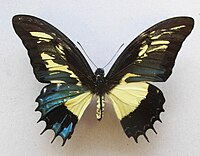Gynandromorf
Gynandromorf (gr. γυνη gynē, γυναικος gynaikos „kobieta”; ανηρ anēr, ανδρος andros „mężczyzna”; μορφη morphē „forma, wygląd”) – organizm mający jednocześnie męskie i żeńskie cechy płciowe. Termin ten jest używany głównie w entomologii. Gynandromorfizm można zaobserwować u motyli, ciem i innych owadów z powodu ich wyraźnego dymorfizmu płciowego. Przypadki gynandromorfizmu stwierdzono także u skorupiaków, zwłaszcza homarów i krabów[1] oraz u ptaków, takich jak m.in. zeberka timorska (Taeniopygia guttata)[2][3], amadyniec (Erythrura gouldiae)[4] i łuszcz strojny (Pheucticus ludovicianus)[5].
Rodzaje rozmieszczenia tkanek męskich i żeńskich

Gynandromorf może mieć dwustronną asymetrię, kiedy jedna połowa (lewa lub prawa) organizmu wykazuje cechy płci męskiej, zaś druga połowa – cechy płci żeńskiej[6]. Gynandromorfizm z asymetrią dwustronną powstaje bardzo wcześnie, kiedy organizm składa się z 8 do 64 komórek[1]. W późniejszym czasie powstaje gynandromorf mozaikowy, u którego cechy męskie i żeńskie nie są już tak wyraźnie rozdzielone.
Papilio androgeus, samiec
W kulturze popularnej
W swojej autobiografii Speak, Memory autor i badacz motyli Vladimir Nabokov opisał przypadki gynandromorfizmu u motyli, męskich po jednej stronie, żeńskich po drugiej, które złapał jako młodzieniec w Rosji, na rodzinnej posesji[7]. W powieści Kim Stanley Robinson 2312, niektórzy ludzie decydują się zamienić się w funkcyjne gynandromorfy. Przykładowo, jej protagonistka, Swan Er Hong, to gynandromorf. Urodziła się jako kobieta i identyfikuje się jako takowa, była matką dla swoich dzieci, ale była również ojcem dzieci, po uzyskaniu męskich organów rozrodczych[8].
Zobacz też
- hermafrodyta
- interpłciowość
- chimera
- androgynia (różne znaczenia)
Przypisy
- ↑ a b David Malmquist: Rare crab may hold genetic secrets. Virginia Institute of Marine Science. [dostęp 2010-03-01]. (ang.).
- ↑ Robert J. Agate, William Grisham, Juli Wade, Suzanne Mann, John Wingfield, Carolyn Schanen, Aarno Palotie, Arthur P. Arnold. Neural, not gonadal, origin of brain sex differences in a gynandromorphic finch. „Proceedings of the National Academy of Sciences”. 100 (8), s. 4873–4878, 2003. DOI: 10.1073/pnas.0636925100. (ang.).
- ↑ X. Chen i inni, Sexually dimorphic expression of trkB, a Z-linked gene, in early posthatch zebra finch brain, „Proceedings of the National Academy of Sciences of the United States of America”, 102 (21), 2005, s. 7730–7735, DOI: 10.1073/pnas.0408350102, ISSN 0027-8424, PMID: 15894627, PMCID: PMC1140405 [dostęp 2019-06-17] (ang.).
- ↑ Gouldian Finch – Gynandromorph. [dostęp 2010-03-01]. [zarchiwizowane z tego adresu (2006-07-16)]. (ang.).
- ↑ Powdermill Banding Fall 2004. [dostęp 2010-03-01]. [zarchiwizowane z tego adresu (2006-12-31)]. (ang.).
- ↑ Ian Sample, Half male, half female butterfly steals the show at Natural History Museum, „The Guardian”, 11 lipca 2011, ISSN 0261-3077 [dostęp 2019-06-17] (ang.).
- ↑ Vladimir Vladimirovich Nabokov, Speak, memory. An autobiography revisited, wyd. Rev. and expanded ed, London: Penguin, 2000, s. 97, ISBN 0-14-118322-5, OCLC 44694703 [dostęp 2019-06-17].
- ↑ Kim Stanley Robinson, 2312, wyd. First edition, New York: Orbit, ISBN 978-0-316-09812-0, OCLC 707964781 [dostęp 2019-06-17].
Linki zewnętrzne
- James K. Adams: Gynandromorphs. Dalton State. [dostęp 2010-03-01]. [zarchiwizowane z tego adresu (2013-03-07)]. (ang.).
- Laura Wright: Unique Bird Sheds Light on Sex Differences in the Brain. Scientific American. [dostęp 2010-03-01]. (ang.).
- David Braun: Photo in the News: Rare He-She Crab Found in Chesapeake. National Geographic News. [dostęp 2010-03-01]. (ang.).
Media użyte na tej stronie
Autor: Notafly, Licencja: CC BY-SA 3.0
Papilio androgeos Male Papilionidae
Autor: Notafly, Licencja: CC BY-SA 3.0
Papilio androgeus female:Papilionidae
Autor: Notafly, Licencja: CC BY-SA 3.0
Papilio androgeus gynandromorph:Papilionidae
Drassodes saccatus; large female specimen with left male palpus. From the original description:









